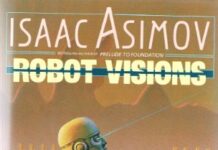
Ebook Info
- Published: 1980
- Number of pages: 182 pages
- Format: EPUB
- File Size: 0.16 MB
- Authors: Isaac Asimov
Description
Casebook of the Black Widowers is a collection of mystery short stories by American author Isaac Asimov, featuring his fictional club of mystery solvers, the Black Widowers. It was first published in hardcover by Doubleday in January 1980, and in paperback by the Fawcett Crest imprint of Ballantine Books in March 1981. This book is the third of six that describe mysteries solved by the Black Widowers, based on a literary dining club he belonged to known as the Trap Door Spiders. It collects twelve stories by Asimov, nine reprinted from mystery magazines and three previously unpublished, together with a general introduction and an afterword following each story by the author. Each story involves the club members’ knowledge of trivia. Contents: “Introduction” “The Cross of Lorraine” “The Family Man” “The Sports Page” “Second Best” “The Missing Item” “The Next Day” “Irrelevance!” “None So Blind” “The Backward Look” “What Time Is It?” “Middle Name” “To the Barest”
User’s Reviews
Reviews from Amazon users which were colected at the time this book was published on the website:
⭐I did not know I was purchasing a used book, but I love Asimov’s Black Widower stories and am so happy to have this collection. I have most of his other books but was missing this one. Like most of his short stories, the characters are what make the stories.
⭐Book was sent as a gift. Arrived in good condition. Recipient quite happy.
⭐Isaac Asimov is one of my favorite authors. The mysteries here are fun and they make you think. I bought this book used, but it was a worthy addition to my library. Great stuff for any mystery lover.
⭐love Asimov’s “black widowers”” stories. I read them for fun and pass it on to anyone that likes to read this type of genre for fun.
⭐I’ve always been a fan of Asimov and his SciFi but the Black Widowers is a change. Short stories of mysteries with a real cast of characters.
⭐I really love these stories. I read them over and over. I wish I had discovered them sooner.
⭐Isaac Asimov is a masterful writer. These books may be old but they are still great.
⭐An oldie but goodie—Asimov was such a wonderful and prolific writer.
⭐CASEBOOK OF THE BLACK WIDOWERS (1980) is the third collection of Isaac Asimov’s Fair-Play Puzzle stories involving a men’s club that meets monthly at a Manhattan restaurant and considers unusual problems, nearly always provided by a dinner guest of one of their members. The cast of all these stories consists of six diverse professional men (an artist, a chemist, a government cryptography expert, a math teacher, a mystery novelist, a patent attorney) and the restaurant’s “incomparable waiter,” Henry Jackson, who invariably is the only person who can propose a satisfactory solution to the problem.Asimov has provided this collection with a short Introduction and has written short Afterwords to each of 12 short stories it contains; 7 of these stories were originally published in ELLERY QUEEN’S MYSTERY MAGAZINE (EQMM), 2 of them were first published in ISAAC ASIMOV’S SCIENCE FICTION MAGAZINE (IASFM), and 3 of them first appeared in this volume. In order of their appearance here, the dozen stories are——1. “The Cross of Lorraine” (EQMM, May 1976); a guest (a magician) learns where he can find a woman he became very attracted to during a bus ride.—2. “The Family Man” (EQMM, Nov. 1976, as “A Case of Income Tax Fraud”); a guest (an I.R.S. agent) learns why he had uncharacteristically failed to suspect a man who was guilty.—3. The Sports Page” (EQMM, Apr. 1977); a guest receives help decoding a “last words” message sent by a dying spy.—4. “Second Best” (1980 in CASEBOOK); a guest (a Korean War vet) receives help learning the name of a G.I. who’d briefly accompanied him during their winter 1950 retreat from the Red Chinese.—5. “The Missing Item” (IASFM, Winter 1977); a guest whose wife is attracted to a cult receives solid proof the cult leader is bogus.—6. “The Next Day” (EQMM, May 1977); a guest (young book editor) receives evidence that a novelist he has been working with has been double-dealing.—7. “Irrelevance!” (EQMM, Mar. 1979, as “A Matter of Irrelevance”); a guest (a high school teacher) learns the basis of a criminal mob’s coded instructions to students who work for it.—8. “None So Blind” (; another guest receives help decoding a “last words” message of another dying spy.—9. “The Backward Look” (IASFM, Sep. 1979); a guest (a would-be writer of a science fiction murder mystery) receives good advice about providing “motivation” for the villain’s actions.—10. “What Time Is It?” (1980 in CASEBOOK); a guest (a defense lawyer) receives help casting “reasonable doubt” on an eye-witness’s testimony about when his client was in the lobby of a hotel.—11. “Middle Name” (1980 in CASEBOOK); a guest who was spurned by a feminist learns the full answer to the test she’d given him.—12. “To the Barest” (EQMM, Aug. 1979); a self-invited guest receives the correct answer to a dead man’s word puzzle, which is worth $10,000.In my judgment, the five best stories are “The Cross of Lorraine,” “The Family Man,” “The Next Day,” “None So Blind,” and “Middle Name.” Of these, “The Cross of Lorraine” is my personal favorite because, uncharacteristically, it provides readers with a touching story as well as a very clever puzzle. Others must like it greatly, too, for it has been reprinted in at least 6 mystery anthologies I know of (3 of which I own), as well as Asimov’s collection THE BEST MYSTERIES OF ISAAC ASIMOV (1986). “Family Man” (which I first read in an Ellery Queen anthology) has a very clever and difficult puzzle involving math. “Middle Name” WAS solvable by me, solely because I was born in the 1940s and attended a high school that DID assign one specific 19th-century book that few readers born after 1950 are likely to have ever read or even heard about. All five of these stories received grades in the “A” range from me.The weakest five stories in my view are “The Sports Page,” “Second Best,” “To the Barest,” “The Backward Look,” and “What Time Is It?” The first four of these stories received grades in the “C” range from me, and the fifth story received a “D” grade because I am certain that its “solution” is a highly implausible stretch of the imagination, which means to me the puzzle that is the backbone of its “plot” is faulty. The story “A Backward Look” contains excellent advice for short story writers in its opening pages, but it is NOT a fair-play puzzle story like the other 11 works in this collection; they all have a single “right solution,” whereas this one ends with a suggestion that is “good enough to please the guest.”The remaining two stories—”The Missing Item” and “Irrelevance!”—received grades in the “B” range from me. When the 12 grades were averaged, the collection as a whole received a solid “B” grade (4 stars).POSTSCRIPT—The copy of CASEBOOK OF THE BLACK WIDOWERS (1980) which I own and which I read is the 1st hardback edition, published by Doubleday & Company. Unlike most other Doubleday books I own, this one has a fairly large number of printing errors. Most of them involve faulty punctuation, but two of them concern the names of Asimov’s characters. Perhaps some or all of these errors have been corrected in later editions.
⭐I never thought I would ever rate anything by Isaac Asimov as low as this, but I must put my hand on my heart and say that the mysteries in this book are for die-hard Asimovians only. Some of the mysteries revolve around arcane areas of Americana as their gas station signs, while others are obvious from the beginning, particularly in one case if you are familiar with the old joke about the Mother Superior and the blind man.All the familiar characters are here with their familiar characteristics – so familiar that I got very irritated when Manny Rubin thumped the table with his fist for the umpteenth time.Isaac Asimov excelled at scientific explanation – the vast majority of his books are non-fiction science popularisation books, and most of his fiction was science fiction, in which explanatory dialogue is always necessary to fill in possible gaps in the readers’ knowledge while basing a story on quantum physics esoterica for example. There can be no doubt that in these fields, Asimov’s clear explanations worked perfectly. In straight fiction, however, they stick out like a sore thumb, especially when the various characters “explain” matters which can hardly be a mystery to the other characters (such as the identity of various large publishing companies in New York.) Asimov even had the intelligent and well-read Henry, the waiter who solves every problem, looking up a publisher’s name in the phone book, when he’d hardly need to if he was as well-read as Asimov intends us to believe.Every story has a little Afterword by Asimov, telling a little anecdote or explaining some background to the tale. These are more or less the best reason for owning the book (and even they are nothing compared to the headnotes and footnotes to his Hugo Winners books).
⭐Part of an Asimov series. The joy is dependant on the attitude of the reader. I found the stories good, but I love Asimov and bought this for my collection
Keywords
Free Download Casebook of the Black Widowers in EPUB format
Casebook of the Black Widowers EPUB Free Download
Download Casebook of the Black Widowers 1980 EPUB Free
Casebook of the Black Widowers 1980 EPUB Free Download
Download Casebook of the Black Widowers EPUB
Free Download Ebook Casebook of the Black Widowers





